Ata-ul-Haye Nasir, Al Hakam
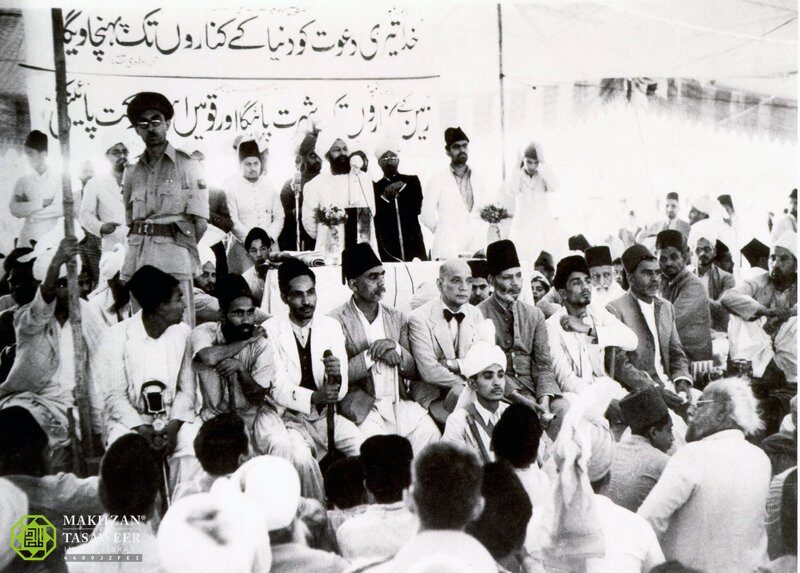
In this era, Hazrat Mirza Ghulam Ahmadas of Qadian, the Promised Messiah and Mahdi, brought a true understanding of the Islamic teachings in accordance with the Holy Quran and the sunnah of the Holy Prophet Muhammadsa. He dispelled the false notions and inferences that had led Muslims astray. After him, his Khulafa are continuing his mission and propagating the true teachings of Islam.
On 22 February 1920, during his lecture in Amritsar, Hazrat Musleh-e-Maud, Mirza Bashir-ud-Din Mahmud Ahmadra said:
“[The Promised Messiahas] proclaimed that God has given him the following glad tiding:
میں تیری تبلیغ کو زمین کے کناروں تک پہنچاؤں گا۔
“[‘I shall carry your message to the ends of the earth.’ (Tadhkirah [English], p. 407)]
“He also announced that God Almighty has told him the following:
فَحَانَ اَنْ تُعَانَ وَتُعْرَفَ بَیْنَ النَّاسِ
“Meaning, ‘The time has come that you should be helped and be recognised among people.’ [Tadhkirah [English], p. 289]
“Then he announced after having received the glad tiding from God Almighty that:
دنیا میں ایک نذیر آیا پر دنیا نے اُس کو قبول نہ کیا لیکن خدا اسے قبول کرے گا اور بڑے زور آور حملوں سے اُس کی سچائی ظاہر کردے گا۔
“Meaning, ‘A Warner came unto the world, but the world accepted him not; yet God shall accept him and demonstrate his truthfulness with mighty assaults.’ (Tadhkirah [English], p. 128) […]
“After his claim, he gained such fame in the world that there is no country or place whose people are unaware of him; his name spread to every country and nation.” (“Truthfulness and progress of Islam: Hazrat Musleh-e-Maud’s lecture at the Vande Mataram Hall in Amritsar, 1920 – Part 2”, Al Hakam, 16 June 2023, Issue 274, p. 12)
The formal establishment of the Ahmadiyya Muslim missions outside of British India began in 1913, when a mission was established in England, followed by a mission in Mauritius and many more in the following years.
In 1934, the Majlis-e-Ahrar’s opposition to Ahmadiyyat was at its peak. On one hand, the Ahrar desired to efface Ahmadiyyat from the face of the earth, on the other, Hazrat Musleh-e-Maudra launched the grand scheme of Tahrik-e-Jadid to spread the message of Islam Ahmadiyyat in the whole world.
For chronological details about the blessed scheme of Tahrik-e-Jadid, see “Tahrik-e-Jadid: The magnum opus of Hazrat Musleh-e-Maud” (Al Hakam, Issue 137, 138 and 139), and for details on Ahrar’s opposition to Ahmadiyyat, see “Historical analysis of Ahrar’s anti-Ahmadiyya agitation” (Al Hakam, Issue 290, 291 and 292).
Through the blessed scheme of Tahrik-e-Jadid, various missions and mosques were established around the world, with the aim to propagate the beautiful teachings of Islam.
In January 1949, the Daily Telegraph and Daily News of Sydney, Australia, published an article titled “Moslems mean to convert us”, by Irene Hanstatter:
“Mirza Bashir Ud Din Mahmud Ahmed[ra], Chief of the Ahmadiyya Moslem Community, which has its headquarters at Lahore (Pakistan), intends to send a missionary to Australia.
“He’s got missionaries in England and many European countries and thinks it [is] time he tackled the Dominions.
“He believes Australia will be [a] hard country to convert to the Islamic religion, especially as the immigration laws make it difficult for Indians to infiltrate into the community. So he wants to start as soon as possible.
“The Imam (leader) of the London Mosque, Mushtaq Ahmad Bajwa, has sent a vanguard of literature to Australia, but expects the missionary to Australia will go fresh from a training course in Pakistan.
“Australians will have a clue to what’s likely to happen after Mahmud Ahmed’s[ra] man arrives, when they know what goes on with London’s Moslem Community. In the last few weeks:
“(i) The Imam’s fezzed missionaries (men only) conducted a leaflet campaign in London’s West End streets.
“(ii) A Bristol Bank clerk turned Moslem missionary — Bryan Orchard, renamed Bashir Ahmed Orchard — went up to the north of England to find a good site for a new mosque.
“(iii) Plans were completed for an additional mosque to be built in West London in the grounds of the Islamic Cultural Centre.
“There are four mosques in England — two in London, one in Woking (Surrey), and one in Gloucestershire.
“The Imam Bajwa’s mosque, ‘the London Mosque,’ is the loveliest. Its white minarets tower, incredibly Arabian-Nightsish, above the grey, prosaic streets of the suburb of Southfields.
“There are about 2000 English Moslems in England, 400 of them Londoners. […]
“The Imam is cheerfully confident that Moslems will convert the rest of England and the world to the faith. He has two main reasons:
“First, the Islamic faith, he says, is more rational than the Christian, and therefore more comforting.
“Second, the Prophet Mohammed[sa] said, ‘The sun will rise in the West,’ which can only be interpreted (says the Imam) as ‘Islam’s sun will rise in the West.’
“The literature the Islamic missionaries hand out seeks to convert Christians by proving that Christ did not die on the cross, but went to India, where his tomb ‘still exists in Kashmir.’
“In Germany recently there have been quite a few converts to the Islamic faith, especially in Hamburg. […]
“Helping English women converts to follow the teachings of the Prophet[sa] is the Imam’s wife, who arrived in England in 1946.” (Daily Telegraph and Daily News, 22 January 1949, p. 14)
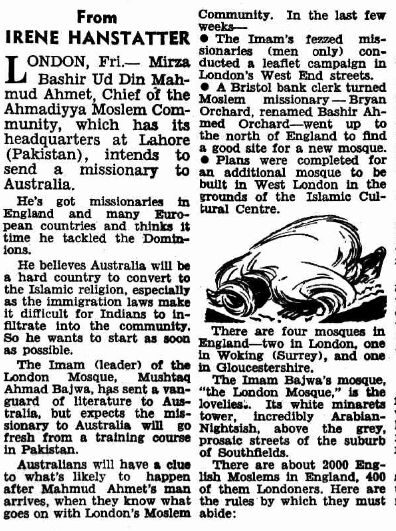
In July 1949, the Sunday Telegraph of Sydney, Australia, mentioned a tabligh event arranged by the Ahmadi missionaries in the Netherlands – Hafiz Qudratullah Sahib and Ghulam Ahmad Bashir Sahib. The article, titled “Hell was only a hospital”, stated:
“Hafiz and Bashir are missionaries for the Moslem Ahmadiyya sect, whose 1,000,000 members have made proselytising one of their major works. Ahmadiyya Moslems already have mosques in Paris, London, Berlin, and Chicago.
“Islam’s missionaries to Holland, however, have not had easy going.
“First schooled in their own soft Urdu, they had to learn the harsh Dutch language. Then they tirelessly passed out leaflets (20,000 a year), at big city railroad stations,” and “among downtown shopping crowds.
“Five times daily, Hafiz and Bashir spread their prayer mats, and, facing toward Mecca, go solemnly through the Moslem prayer ritual.
“‘Sometimes,’ says Bashir, ‘we get awfully homesick; then we work very hard and pray to forget it.’ […]
“Nervous Archivist Plet van Wijk, 41, made a glowing speech about the beauty of Islamic prayer.
“Suave, moustached Zeno de Lyon explained that Islam always taught the middle road.
“‘With their system,’ said Zeno, ‘one can avoid both Communism and capitalism.’
“Hafiz and Bashir denounce the doctrine of original sin.
“‘How cruel,’ says Hafiz ‘to think a new-born baby is a sinner.’
“Bashir adds cheerfully: ‘Islam says Heaven is eternal, but that Hell is only temporary. Hell is like a hospital, a place where people get better.
“In two years, Hafiz and Bashir have made 10 Dutch converts (four of them women).
“About 40 people attend their monthly meetings.
“Yet Hafiz and Bashir are sure all Holland will be Moslem in 100 years.” (Sunday Telegraph, 24 July 1949, p. 28)

On 25 May 1958, The Sunday Times of London published an article “Fanning the Flame of Islam”. It was the concluding article of a series by Elspeth Joscelin Huxley, reporting on her visit to East Africa. In this article, she mentioned the Muslim communities of East Africa, and also mentioned the services of the Ahmadiyya Muslim Community to propagate Islam and translate the Holy Quran into various languages.
Elspeth Joscelin Huxley (1907-1997) was an English writer, journalist, broadcaster, and government adviser. She wrote over 40 books.
In her above-mentioned article, she wrote:
“At the other extreme lies the Ahmadiyya sect, which holds the interesting belief that Jesus[as], far from dying on the Cross, made his way to Kashmir and is buried at Srinagar; and that the Second Coming was fulfilled in the person of Mirza Ghulam Ahmad[as] Quadiani, who died in 1908. Although most of its adherents are Punjabis, the sect has mosques in Britain, Holland, Germany, the United States and elsewhere.
“In East Africa, it maintains several newspapers and has translated the Quran into Kiswahili, with a first printing of 10,000; a new Kikuyu translation is on the way. Among the peoples of the Lake Victoria basin, now active in Kenya politics, Ahmadiyya missionaries are gaining converts steadily; in fact the sect, which started in Tanganyika, appears to be spreading in most parts of Eastern Africa.
“Its missionaries, sent over from Pakistan, are mostly men of impressive intellect and force of character, and the rule, that every adherent must give one-tenth of his income to further his faith, provides funds for further advance. […]
“The faith spreads slowly, from man to man. In places it is stagnant, and no doubt Islam has its renegades like every other faith. But by reason of its dignity, the straightforward discipline, the fellowship of the mosque and, above all, its tolerance of African marriage customs and approval of polygamy, Islam makes a strong appeal.” (The Sunday Times, 25 May 1958, p. 20)

The Promised Messiahas brought a true understanding of the Holy Quran to the world, dispelling the false notions and inferences attributed to the Most Perfect Book. After him, his Khulafa are continuing his mission and propagating the true teachings of the Holy Quran. For this purpose, under the guidance of Khilafat-e-Ahmadiyya, Jamaat-e-Ahmadiyya has been able to translate the Holy Quran into various languages of the world.
In 1915, the first part of the English translation of the Holy Quran with explanatory notes was published, which was based on the commentary by Hazrat Musleh-e-Maudra.
The Jewish Herald of Melbourne, Australia, published a review on this translation, and stated:
“A new English translation is now being prepared by a society in India for the advancement of the Muslim religion, called Anjuman-i-Taraqqi-i-Islam. A few months ago we received a specimen page or two of the translation, and, as we intimated in a brief notice at the time, were favourably impressed with the plan of the projected work. We have now been favoured with a copy of the first completed instalment of the book, and can only say that the progress thus far made amply fulfils the promise given at the inception of the undertaking. The scale on which the work is designed may be inferred from the fact that the First Part, which consists of 117 large pages (and of which, by-the-way, the typography and general get-up are admirable), is only one-thirtieth of the Quran. […]
“This new translation of the Quran, besides its interest for the general reader and the inquirer into the rise and growth of religious systems, should prove of particular value to the student of Arabic, who will find the inclusion of the original text a great convenience. From the linguistic and literary point of view, the Quran, in diction and style, is by common consent regarded as the standard of pure classical Arabic. The light this language often throws upon obscure and difficult points of Hebrew, with which language it has a family affinity, gives it a claim to the serious attention of such of our co-religionists as are desirous of acquiring a thorough knowledge of their own sacred tongue.” (The Jewish Herald, 15 December 1916, p. 12)
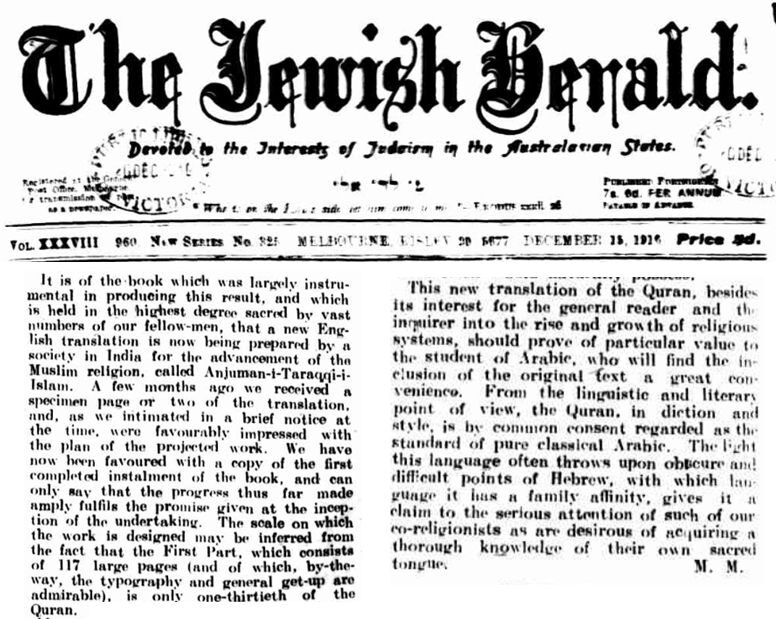
The Harvard Theological Review of October 1917 and The Civil and Military Gazette of 10 August 1916 also published reviews on this translation of the Holy Quran.

During his Friday Sermon on 20 October 1944, Hazrat Musleh-e-Maudra called the attention of the Jamaat towards translating the Holy Quran into eight major languages of the world, including Russian, French, German, Italian, Spanish, and Portugees. (Khutbat-e-Mahmud, Vol. 25, pp. 594-597)
Thereafter, in accordance with Hazrat Musleh-e-Maud’sra advice, Jamaat-e-Ahmadiyya has been able to translate the Holy Quran into various languages.
The Dutch translation of the Holy Quran was published in 1953. Mentioning this, The Barrier Miner of Broken Hill, Australia, wrote:
“The Hague: A new Dutch translation of the sacred book of the Mohammedans, the Koran [sic., Holy Quran], was recently printed and published by the South Holland Publishing Co., The Hague. The first two copies have just been flown by K.L.M. Constellation to Karachi and Jakarta, for presentation to the Head of the Ahmadiya Moslem Movement and [Indonesian] President Soekarno, respectively. The original Dutch translation, made in 1707, was incorrect and out of date, and so the leaders of the Ahmadiya Moslem Movement – which originated in Rabwah, Pakistan [sic.] – decided to issue a revised version, not only in Dutch but also in English, French, German and Russian, while Spanish and Italian translations will follow in due course.
“In accordance with Moslem custom, these two copies of the Koran [sic., Holy Quran] will be carried above the heads of the crew during the flight.” (The Barrier Miner, 6 January 1954, p. 8)
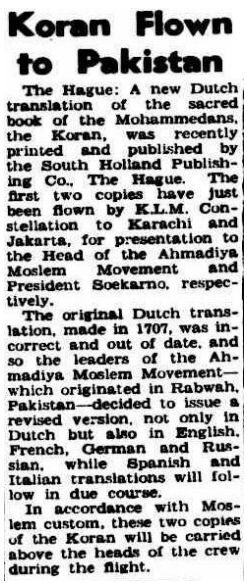
Mentioning the services of Ahmadiyyat in regards to the Holy Quran’s translation into different languages, Hazrat Musleh-e-Maudra once said that Allah has decreed all of these blessings for us and its fulfilment is due to the blessings of Khilafat:
“We had the opportunity to accomplish the task that the strongest of the [Muslim] kings could not do. […] This is the blessing of Khilafat and unity, which has enabled the Jamaat to publish the Holy Quran’s translation into various languages.” (Khitabat-e-Shura, Vol. 3, p. 600)
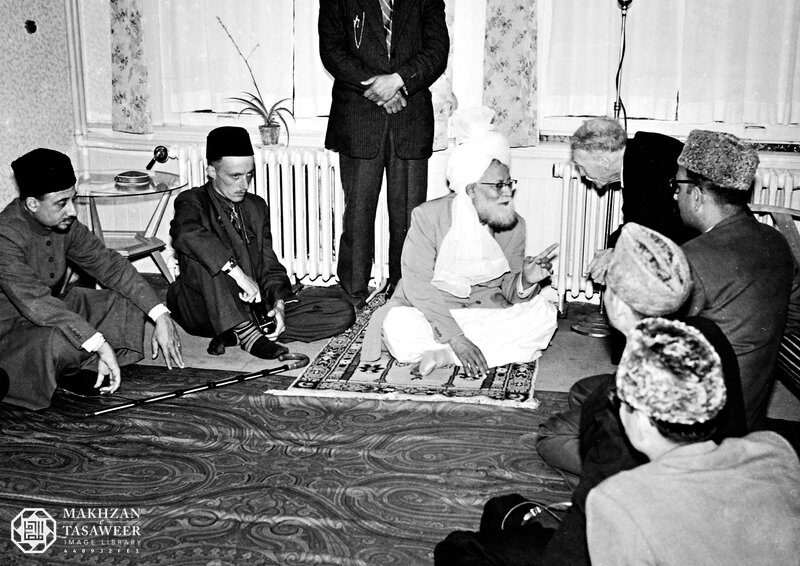
Indeed, the continuous progress of Ahmadiyyat which we witness today, by the grace of Allah Almighty, is due to the blessings of Khilafat.
During his Friday Sermon on 30 September 2022, Hazrat Mirza Masroor Ahmad, Khalifatul Masih Vaa, said:
“We will find true happiness and joy only when we bring the entire world into the subservience of the Holy Prophetsa. To achieve this, we must seek out new avenues of propagating Islam […]. We must present the arguments of the Messiah of Muhammadsa to the world. More so than ever, we must improve our actions and spiritual states. […] The Muslims started to face decline only when the world became more important to them; their standards of righteousness began to fall and their regard for worship continued to decrease. However, because it was the promise of Allah the Almighty to the Holy Prophetsa that this religion would remain established and will be granted strength until the Day of Judgement, He sent the Promised Messiah and Mahdias in the Latter Days. After his advent, the Promised Messiahas informed the world of his coming and despite not having sufficient means, his message reached Europe and America and many other countries.” (Al Hakam, 28 October 2022, Issue 241, p. 16)
The blessed scheme of Tahrik-e-Jadid is continuously manifesting its fruits, i.e. playing its part in the propagation of Islam to all corners of the world. Ahmadiyyat is achieving great victories under the blessed leadership of Hazrat Khalifatul Masihaa, alhamdulillah, and it will continue to flourish, insha-Allah.

